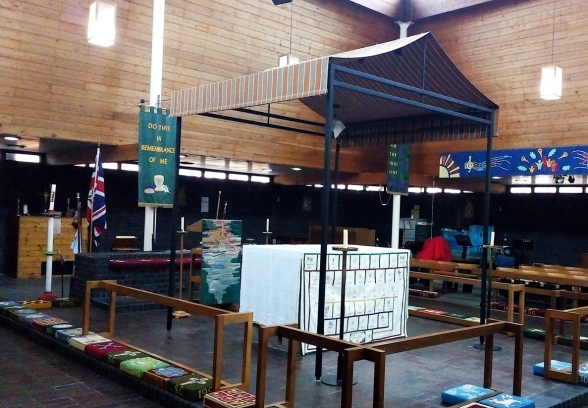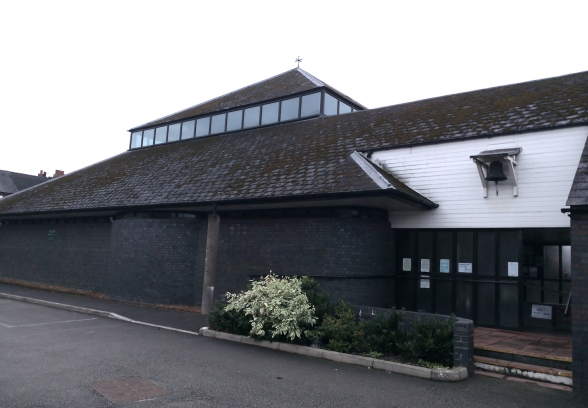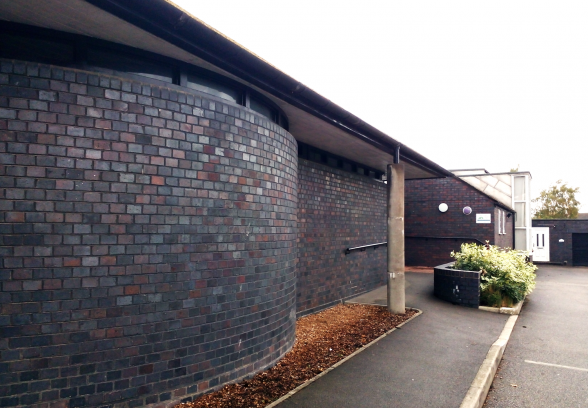This website uses cookies
This website uses cookies to enable it to function properly and to analyse how the website is used. Please click 'Close' to accept and continue using the website.





December 2018 - All Saints Church, Crewe, Cheshire
Maguire & Murray, 1962-7
Millions of rail passengers travel through Crewe. Those who leave the station will find a railway town of nineteenth century redbrick terraced and semi-detached houses. Yet, about two kilometres away from the station, is a striking modern church, described in the 1968 Architects’ Journal as ‘one of the most significant churches built in any country since the war’.
All Saints, Stewart Street, was designed by Robert Maguire and Keith Murray, well-known for their churches, schools, student college accommodation, Pembroke College, Oxford, and Kita housing in Berlin-Kreuzberg.
They were commissioned in 1961 and the church was built in 1964-5. They intended to develop liturgical-spatial ideas from their churches of St Paul’s, Bow Common, London, and St Matthew’s, Perry Beeches, Birmingham. In the early sixties there was a trend in church architecture to focus on a centrally placed altar; worship in the round, as it were. Maguire and Murray further developed this approach at All Saints, predating the central altar of Gibberd’s Roman Catholic Metropolitan Cathedral in Liverpool (1962-7).
All Saints has a square plan but with subtly rounded corners. A narrow clerestory strip, beneath the deep eaves of a low-pitched pyramidal roof, seems to float the roof above the hall. A broader clerestory divides the tiers. Walls are built in Staffordshire blue brick; the roof is covered with dark asbestos slate. The effect is unassertive in a townscape of terraced houses. Materials are in the local tough industrial functional style fitting in a town of railway workshops.
The intimate interior contrasts with the dark brick exterior. Inside all is natural light and focused on the central altar beneath its market-style baldacchino. Seating on simple benches with rippled back-rests is arranged round three sides of the altar. The continuous clerestory strip beneath the roof lightens the interior with its urendered brick walls. The interior, with its warm-looking 1960s boarded ceilings and original lamps in their spruce shades, is remarkably unaltered. The concrete font is circular with exposed shuttering. It is north east of the altar, with a convex bulged projection in the wall behind it. The entrance, which may seem obscure from the street, is between the church and the adjacent hall.
The church social hall was designed for use as a youth club and for meetings of parish groups such as the Mothers’ Union. It has a small kitchen and dining area beneath a wood boarded ceiling. The church and hall were linked to the vicarage but this link is no longer used. There is a peaceful interior garden next to the church and hall.
Gerald Adler, in his 2012 monograph on Murray & Maguire, notes the AJ reviewer’s comments that All Saints contrasts with Murray & Maguire’s earlier churches in London and Birmingham: ‘These churches both have an element of tough ‘protest’ about them, of the kind which led to comparisons with Butterfield. All Saints is a gentler, more domestic conception, and it shows a rare feeling for the quality of the nineteenth-century urban environment.’
All Saints is unlisted.
Aidan Turner-Bishop, Chair, C20 Society North-West group
References
Adler, Gerald (2012) Robert Maguire & Keith Murray (RIBA Publishing)
Architects’ Journal (4 September 1968) pp. 453-464
Christliche Kunstblätter (1970) No.2, p.61 and pp.78-82
Hartwell, Clare, et al. (2011) Cheshire: Buildings of England (Yale U.P.)
Harwood, Elain (1998) ‘Liturgy and architecture: the development of the centralised Eucharistic space’, in: Twentieth Century Architecture 3: The Twentieth Century Church, (Twentieth Century Society) pp. 50-74
Heathcote, Edwin & Spens, Iona (1997) Church Builders (Academy) pp.68-73
Look for past Buildings of the Month by entering the name of an individual building or architect or browsing the drop down list.

Become a C20 member today and help save our modern design heritage.